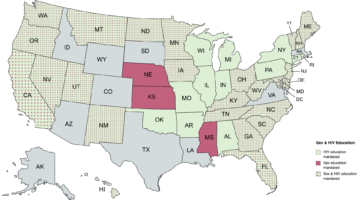Sex Question Friday: How Safe Is “Safe Sex?”
October 31, 2014 by Justin Lehmiller
Every Friday on the blog, I answer people’s questions about sex, love, and relationships. This week’s question comes from a female reader who wanted to know the following:
“Everyone talks about practicing safe sex and I do, but how safe am I when I’m using condoms and is there anything else I should be doing?”
Thanks for this great question! Condoms can be very effective at preventing unintended pregnancies and sexually transmitted infections (STIs) when used properly; however, studies suggest that people overestimate how effective condoms are in practice [1]. This means that when you’re practicing “safe sex,” you may not be quite as safe as you think.
One reason people overestimate the effectiveness of condoms is probably because we’ve all heard the statistic that condoms are 98% effective at preventing pregnancy. This statistic is technically accurate [2]; however, it is based on the assumption of perfect use (i.e., that heterosexual couples will always use condoms and never make any mistakes). In reality, condom use tends to be far from perfect. Condom use errors are common and include things like putting the condom on too late or removing it too early, using incompatible lubricants (e.g., oil-based lubes with a latex condom), and accidentally puncturing the condom with sharp objects (e.g., when scissors are used to open the package). In addition, many men report problems finding condoms that fit well, which increases the likelihood of breakage and slippage. The end result is that when you factor in human error and other issues people encounter, the actual (i.e., typical use) effectiveness rate for pregnancy prevention drops to 82%, which you may be surprised to learn is only slightly better than the 78% typical use rate of the withdrawal (i.e., “pull and pray”) method [2]! In light of this, don’t let perfect use rates lull you into a false sense of security. Pay more attention to typical use rates instead because they are more reflective of reality.
So how effective are condoms at preventing STIs? Unfortunately, that’s a much more difficult question to answer–it’s not like we can conduct a true experiment where we randomly assign uninfected people to have sex with infected partners with our without condoms and see how many times diseases are transmitted. However, lab studies tell us that condoms are effective barriers to the passage of infectious organisms (see here for a list of studies compiled by the Centers for Disease Control). Also, studies of romantic couples in which one partner has HIV and the other doesn’t have shown that when the infected partner is on anti-retroviral medication and the couple uses condoms, the risk of infection transmission is near zero [3].
Of course, lab studies don’t necessarily reflect what happens in the real world (e.g., they don’t account for condom use errors), and studies of romantic couples may not be generalizable to people having casual sex because people who love each other may put more effort into making sure that condoms are used consistently and correctly.
There are several reasons to suspect that the effectiveness of condoms at preventing STI transmission is probably a bit lower compared to preventing pregnancy. For one thing, STI organisms are even smaller than sperm cells. In addition, certain infections may reside on the skin in areas that are not covered by condoms (e.g., herpes, HPV) and STIs have the potential to be spread during multiple sexual activities (including oral, vaginal, and anal sex).
The pregnancy prevention rate is artificially inflated to begin with due to the fact that pregnancy cannot always occur–after all, women are not ovulating constantly. This means that even if no method of pregnancy prevention is employed over the course of a year, 100% of women will not become pregnant. In reality, 85% will become pregnant because sexual encounters are not always timed with women’s peak fertility [2]. In contrast, STIs can be spread no matter what time of the month it is.
What all of this means is that when we teach about condoms as a form of “safe sex,” we may be over-promising and under-delivering. It is important that our teachings reflect the fact that condoms do not make sex inherently “safe”—sex just becomes safer than it otherwise would have been. It would probably be wise to think about condoms as a form of “safer sex.”
Don’t let all of this scare you away from sex, though! Just make sure that you have appropriate expectations for the level of protection you can expect from condoms and remember that there are other things you can do to reduce risks even further. For instance, given that condoms are far from perfect devices, it means that STI testing isn’t something to be reserved only for cases in which you didn’t use a condom or the condom broke—you can still potentially get some STIs even if you use condoms all of the time and use them correctly. Also, don’t put off testing until you notice something is wrong. Not all STIs have immediate symptoms (e.g., gonorrhea, chlamydia, HIV), so it’s very possible to have an infection and feel fine. In other words, using condoms and being symptom free is not a substitute for visiting the doctor every now and then. If you’re sexually active, and especially if you or your partner have multiple partners, you should get tested occasionally.
It is probably also worth keeping a stockpile of condoms around so that they are there when you need them. However, brush up on proper condom use (see here or here) and remember that condoms, like Twinkies, have expiration dates and aren’t good forever—you will need to check those dates and replace any that have expired. Also, if you’re concerned about pregnancy prevention, it is advisable to use more than one method of protection (e.g., condoms plus birth control pills) so that you can further reduce the potential for an unintended pregnancy while simultaneously taking advantage of condoms’ unique ability to reduce infection risk.
Lastly, be sure to communicate with your partner. Ask your partner about their STI status and how recently they were tested, but be prepared to reveal the same information about yourself (and to be honest!). I know this is easier said than done because talking about STIs isn’t very sexy—but remember that giving and getting STIs isn’t very sexy either.
The reality is that if you’re going to be sexually active, you have to accept some degree of risk; however, there is a lot you can do to minimize the risks and this starts by recognizing that there’s no such thing as “safe sex”—there is only safer and smarter sex.
Want to learn more about Sex and Psychology ? Click here for previous articles or follow the blog on Facebook (facebook.com/psychologyofsex), Twitter (@JustinLehmiller), or Reddit (reddit.com/r/psychologyofsex) to receive updates.
[1] Eisenberg, D. L., Secura, G. M., Madden, T. E., Allsworth,
J. E., Zhao, Q., & Peipert, J. F. (2012). Knowledge of contraceptive effectiveness. American Journal of Obstetrics and Gynecology, 206(6), 479-e1.
[2] Trussel, J. (2011). Contraceptive failure in the United States. Contraception, 83, 397-404.
[3] Attia, S., Egger, M., Müller, M., Zwahlen, M., & Low, N. (2009). Sexual transmission of HIV according to viral load and antiretroviral therapy: Systematic review and meta-analysis. Aids, 23, 1397-1404.
Image Source: 123RF

Dr. Justin Lehmiller
Founder & Owner of Sex and PsychologyDr. Justin Lehmiller is a social psychologist and Research Fellow at The Kinsey Institute. He runs the Sex and Psychology blog and podcast and is author of the popular book Tell Me What You Want. Dr. Lehmiller is an award-winning educator, and a prolific researcher who has published more than 50 academic works.
Read full bio >


